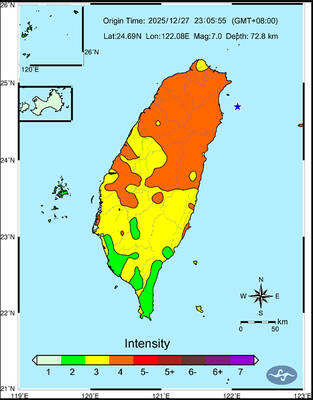Human rights advocates yesterday called on Beijing to stop the repression of people in Tibet, Inner Mongolia and Xinjiang, and blamed the recent cases of self-immolation by Tibetans and ethnic conflict in Xinjiang on the Chinese government.
“The situation in Tibet and East Turkestan [another name for Xinjiang] is becoming critical as 25 people have set themselves on fire in Tibet since March last year — of which 15 have died — and there have been violent clashes between Uighurs and Chinese in East Turkestan,” Taiwan Friends of Tibet chairperson Chow Mei-li (周美里) told a press conference.
“The Chinese government may claim that [Tibetan spiritual leader] the Dalai Lama is behind the suicides and that foreign ‘terrorist’ groups are fanning ethnic conflict in East Turkestan ... [but] the authoritarian rule of the Chinese government in these places should instead be blamed,” she said.
Tseng Chien-yuan (曾建元), an associate professor at Chung Hua University’s department of public administration, also blamed Chinese authorities for the recent violence.
“Since this recent outbreak of uprisings against Chinese rule in Tibetan communities throughout China, the Chinese Communist Party has launched a ‘patriotic education campaign’ through which they have asked Tibetan Buddhist temples to hang portraits of Chinese leaders such as Mao Zedong (毛澤東), Deng Xiaoping (鄧小平) and Hu Jintao (胡錦濤) instead of their religious leaders, such as the Dalai Lama,” Tseng said. “If you are a monk or even an average Tibetan, how could you tolerate such acts and how could you not do something about it? ”
Tenzin Tsundue, a Tibetan poet and independence activist who was born in exile in India, said China’s occupation of the region had become a major source of public discontent among Tibetans and that while information and images of the current situation in Tibet might be blocked, many people are choosing to sacrifice themselves through self-immolation.
“Self-immolation is the last act that a human being can take to express their freedom and the freedom of their country,” Tenzin said. “The hope is that the news of the self-immolations will at least get to the outside world.”
Political analyst Paul Lin (林保華), who has been in close contact with Uighur activists, said recent attacks on Han Chinese residents in Xinjiang has sent a clear message to Beijing: Uighurs do not want any more ethnic homogenization.
“Between 1949 and 1953, when the China first took over East Turkestan, 75 percent of the population were Uighurs. By the end of the Cultural Revolution [in 1976], the percentage dropped to about 60 percent. In 2000, only 45 percent were Uighurs,” Lin said.
“In the name of anti-poverty programs, China has sent tens of thousands of young, unmarried Uighurs to work in China’s more developed coastal provinces and the purpose is clear: They want to detach young Uighurs from their culture and hope that they will end up marrying Han Chinese as well,” Lin said.
The Chinese government should be blamed for the “poverty” issue since Beijing has taken most of Xinjiang’s natural resources from the local population, he added.

A magnitude 7.0 earthquake struck off Yilan at 11:05pm yesterday, the Central Weather Administration (CWA) said. The epicenter was located at sea, about 32.3km east of Yilan County Hall, at a depth of 72.8km, CWA data showed There were no immediate reports of damage. The intensity of the quake, which gauges the actual effect of a seismic event, measured 4 in Yilan County area on Taiwan’s seven-tier intensity scale, the data showed. It measured 4 in other parts of eastern, northern and central Taiwan as well as Tainan, and 3 in Kaohsiung and Pingtung County, and 2 in Lienchiang and Penghu counties and 1

FOREIGN INTERFERENCE: Beijing would likely intensify public opinion warfare in next year’s local elections to prevent Lai from getting re-elected, the ‘Yomiuri Shimbun’ said Internal documents from a Chinese artificial intelligence (AI) company indicated that China has been using the technology to intervene in foreign elections, including propaganda targeting Taiwan’s local elections next year and presidential elections in 2028, a Japanese newspaper reported yesterday. The Institute of National Security of Vanderbilt University obtained nearly 400 pages of documents from GoLaxy, a company with ties to the Chinese government, and found evidence that it had apparently deployed sophisticated, AI-driven propaganda campaigns in Hong Kong and Taiwan to shape public opinion, the Yomiuri Shimbun reported. GoLaxy provides insights, situation analysis and public opinion-shaping technology by conducting network surveillance

‘POLITICAL GAME’: DPP lawmakers said the motion would not meet the legislative threshold needed, and accused the KMT and the TPP of trivializing the Constitution The Legislative Yuan yesterday approved a motion to initiate impeachment proceedings against President William Lai (賴清德), saying he had undermined Taiwan’s constitutional order and democracy. The motion was approved 61-50 by lawmakers from the main opposition Chinese Nationalist Party (KMT) and the smaller Taiwan People’s Party (TPP), who together hold a legislative majority. Under the motion, a roll call vote for impeachment would be held on May 19 next year, after various hearings are held and Lai is given the chance to defend himself. The move came after Lai on Monday last week did not promulgate an amendment passed by the legislature that

AFTERMATH: The Taipei City Government said it received 39 minor incident reports including gas leaks, water leaks and outages, and a damaged traffic signal A magnitude 7.0 earthquake struck off Taiwan’s northeastern coast late on Saturday, producing only two major aftershocks as of yesterday noon, the Central Weather Administration (CWA) said. The limited aftershocks contrast with last year’s major earthquake in Hualien County, as Saturday’s earthquake occurred at a greater depth in a subduction zone. Saturday’s earthquake struck at 11:05pm, with its hypocenter about 32.3km east of Yilan County Hall, at a depth of 72.8km. Shaking was felt in 17 administrative regions north of Tainan and in eastern Taiwan, reaching intensity level 4 on Taiwan’s seven-tier seismic scale, the CWA said. In Hualien, the